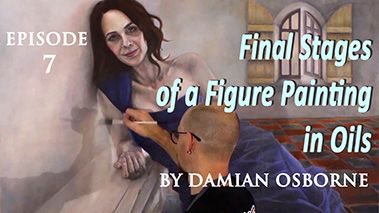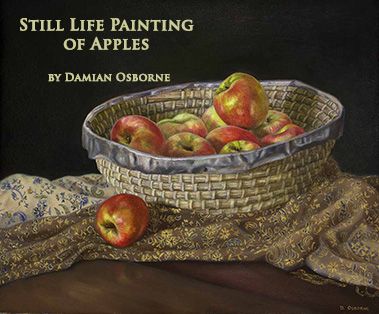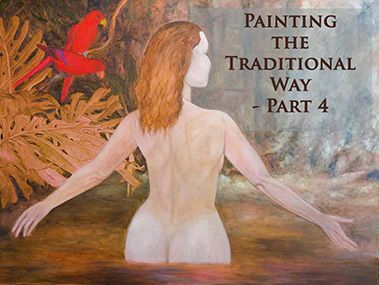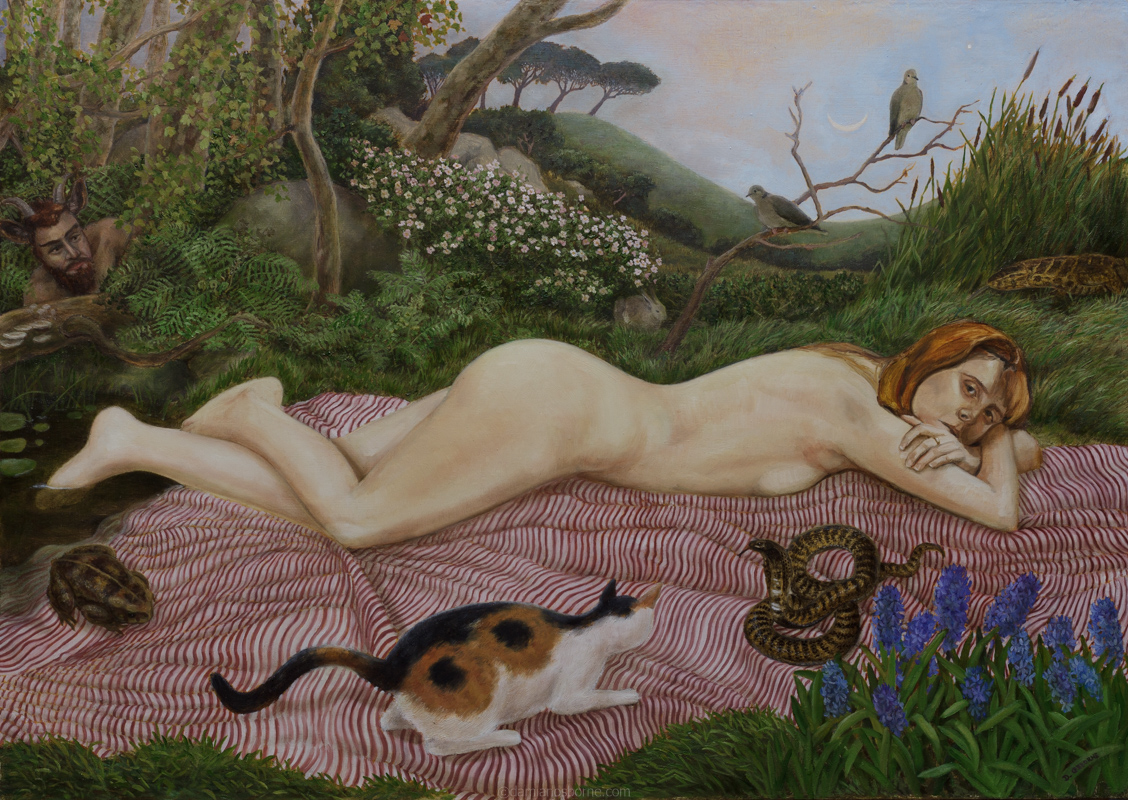Recent Contemporary Realist Oil Paintings These are some of my recent contemporary realist oil paintings, painted mostly from life or imagination. I used a combination of good quality commercial oil paints and my own hand-ground oil paint made in the traditional Old Master’s method for these paintings. Click on an image to view larger file size. The medium is always my own traditional hand-refined linseed oil, which is far superior and faster drying than the thin heat-pressed linseed oil found in art shops. The figure paintings are either from…

Making Vine Black Oil Paint (and Drawing Charcoal)
Watch this video on YouTube Making Vine Black Oil Paint (and Drawing Charcoal) — The Alchemical Journey Series — by Damian Osborne 1 | What is vine black? 2 | Other names and methods of producing a charcoal black 3 | How does vine black oil paint compare with other black pigments? 4 | How do you make homemade vine charcoal for drawing? 5 | What will you need to make vine black oil paint? 6 | How do you make vine black oil paint? 7 | What are some examples of vine black being used by the Old…

Making Graphite Oil Paint
Watch this video on YouTube Making Graphite Oil Paint — The Alchemical Journey Series — by Damian Osborne 1 | What is graphite actually? 2 | Can you mix graphite and oil paint 3 | When was graphite first used as an art medium? 4 | How does graphite black oil paint compare with other black pigments? 5 | How do you make graphite black oil paint? 6 | Did any of the Old Masters use graphite oil paint? Continuing with my handmade paint series, The Alchemical Journey, I decided to experiment with graphite oil paint. Graphite black…

A Little Nocturne Oil Painting
Click to view the painting. A Little Nocturne Oil Painting by Damian Osborne Light the scented candles, put on that old Chopin CD and pour another glass of red. I’m in the mood for a little nocturne oil painting. This scene made a very strong impression on me as I regarded the crescent moon hanging like a shining eyelash between the mountain buttresses one evening. It’s a little corner of wildness, this exposed section of the peninsula at the end of the mountain range, with incessant gale-force winds from the sea, slamming against the rock faces and my back.…

Making Bone Black Oil Paint
Watch this video on YouTube Making Bone Black Oil Paint — The Alchemical Journey Series — by Damian Osborne 1 | What is bone black pigment? 2 | How long does bone black oil paint take to dry? 3 | When was bone black first used? 4 | Bone black vs ivory black 5 | How does bone black oil paint compare with other black pigments? 6 | What does bone black symbolise? 7 | What equipment will you need to make bone black oil paint? 8 | How do you make bone black oil paint? 9 | What…

Final Stages of a Portrait Painting
Watch this video on YouTube Final Stages of a Portrait Painting — Nigredo by Damian Osborne 1 | What pigments will I need for painting a portrait? 2 | Should you add chalk to your oil paint? 3 | How do you mix colours for the Verdaccio? 4 | How many stages do you need for a portrait painting in oils? Here are the final stages of a self-portrait painting I called ‘Nigredo’ (or the crucifixion). Using my own oil paints, I show a quick summary of the various stages of the portrait, beginning with the Verdaccio.…

Underpainting Stage for a Self-Portrait
Watch this video on YouTube Underpainting Stage for a Self-Portrait — ‘Nigredo’ by Damian Osborne 1 | How do you begin the underpainting stage of a portrait painting? 2 | Can you oil paint directly over charcoal? 3 | Making my own oil paint from Bloodstone In this self-portrait oil painting, I start with a charcoal drawing, then make my own oil paint from bloodstone for the underpainting stage of the painting. This is a self-portrait oil painting called ‘Nigredo’. It comes from a pretty dark place. Nigredo is the first stage of the alchemist’s journey. The putrification. Annihilation.…

The Siren Paintings
The Siren Paintings by Damian Osborne “You will come to the Siren (paintings) first of all; they bewitch any mortal who approaches them.” —Homer, The Odyssey Click on an image to view. To view all figure painting archives, go to Figure Paintings. Sirens You see, they sang to me in my own voice, how was I to know? They wove the gauze of waking sleep around my heart, I learnt to love the flightless yearning in their voices, carried on the wind from the island where they starve, for company, their wingfeathers lost to the Muses…

Making Your Own Refined Linseed Oil
Watch this video on YouTube Making Your Own Refined Linseed Oil (Like the Old Masters) by Damian Osborne 1 | Linseed oil and yellowing 2 | Why make your own refined linseed oil? 3 | The salt and sand linseed oil refining process 4 | What you’ll need for refining linseed oil with the salt and sand method: 5 | How to refine linseed oil with the salt and sand method: 6 | What is the difference between cold-pressed, heat-bodied, sun-bleached, stand, and burnt-plate linseed oil for oil painting? Making your own refined linseed oil as a medium for…

Making Your Own Canvas Panels for Oil Painting
Watch this video on YouTube Making Your Own Canvas Panels for Oil Painting by Damian Osborne Making your own canvas panels is a great cost-saver when it comes to being a painter. This is how I make mine with my own homemade primer. Before the invention of oil painting on sailcloth canvas, artists during and before the Renaissance Period commonly painted on solid wooden panels. These were carefully selected pieces of hardwood, and painstakingly sized with hide glues and primed with gypsum or lead-based primers, in preparation for egg tempera or oil painting. Today, making your own canvas panels…

Best Ideas for Oil Painting Every Painter Should Try
Watch this video on YouTube Best Ideas for Oil Painting Every Painter Should Try by Damian Osborne So, you’re wondering what you should paint? Here are some of my personal favourite ideas for oil painting: 1 | Landscape painting 2 | Seascape painting 3 | Still life painting 4 | Figure painting 5 | Self-portrait painting 6 | Painting portraits of your friends and family 7 | Painting animals 8 | Dreams, fantasy, mythological, allegorical and imaginary painting Throughout the history of painting, artists have found inspiration for their art from these universal and personal subjects. What were…

Alla Prima Still Life Painting Demo
Watch this video on YouTube Alla Prima Still Life Painting Demo by Damian Osborne Painting an alla prima still life is a really valuable exercise for any artist. For this still life painting demo, I set up some apples in an African bowl. The painting was another still life commission for a collector in the U.K. In my last post, I showed how to stretch a canvas for painting. I showed how to make a strainer frame and talked about the differences between a strainer and stretcher frame, and the pros and cons of each for stretching canvas. I…

How to Stretch a Canvas for Painting — the Easy Way!
Watch this video on YouTube How to Stretch a Canvas for Painting — the Easy Way! by Damian Osborne As an artist, knowing how to stretch a canvas is important. Not only does it save you a lot of money. But by stretching and priming your own canvases, you’ll gain a better understanding of your materials, and the possible defects of painting in general. You’ll also learn of the various options available regarding painting supports. And, by stretching your own canvas, you’ll be assured of the quality of the materials at each step, since you’re the one who decides…

Weird Questions Beginner Oil Painters Ask
Weird Questions Beginner Oil Painters Ask by Damian Osborne 1 | When does one do underpainting? And is that synonymous with a wash or blocking in? 2 | If you do an underpainting, what medium do you prefer to use? 3 | How many layers of oil paint can you pile on top of the underpainting? 4 | Do you paint an oil painting in subsequent layers by just adding more oil? Or is it more paint? 5 | Can I use acrylic under an oil painting? 6 | What is the difference between alkyd medium and linseed…

Final Stages of a Figurative Painting – Painting the Figure – Part 4
Watch this video on YouTube Final Stages of a Figurative Painting Painting the Figure – Part 4 by Damian Osborne Figurative painting has become the main ‘body’ of my work. This painting is part of my Siren Series, where I depict a female figure in isolation before the sea. If you missed the last blog, I started working on painting the skin tone. In this chapter, I complete this figurative painting with several stages of glazing. What are two different techniques for figurative oil painting? Artists who paint the figure in oils can usually be divided into…

Painting the Skin Tone – Painting the Figure – Part 3
Watch this video on YouTube Painting the Skin Tone Painting the Figure – Part 3 by Damian Osborne There are many styles, colour palettes and methods artists present and past used for painting the skin tone, and of course it won’t do to just mix a universal ‘flesh colour’. Although I like to study as much of the old masters and their palettes as I can, as well as living artists’ methods, colour mixing is pretty intuitive for me; I’m thinking more in terms of colour temperature and value than following someone else’s method, rules, or anything else.…

Painting the Halftones – Painting the Figure – Part 2
Watch this video on YouTube Painting the Halftones Painting the Figure – Part 2 by Damian Osborne So, what are halftones in oil painting exactly? After I painted the grisaille (or ‘dead layer’) in the first chapter of this series, I was left with a cool grey, almost bluish skin tone because of the cooling effect white has over the raw umber imprimatura. So now I need to consider the values (light and dark), the colour hues (what actual local colours I need for the skin tones), and what colour temperatures I want to use for the skin,…

Painting the Figure – Part 1
Watch this video on YouTube Painting the Figure – Part 1 by Damian Osborne This painting is actually part of my Siren Series. I have broken up this figure painting demo into 4 parts. So stay tuned for explanations of the various stages. How do you start a figure painting with charcoal? Vine charcoal is the best medium for starting a figure painting because it’s easy to wipe away and make corrections to your drawing. It is also perfect for drawing on canvas. Unlike graphite, it is soft, and does not create the typical graphite sheen that…

Final Stages of a Figure Painting in Oils
Watch this video on YouTube Final Stages of a Figure Painting in Oils by Damian Osborne Usually when I’m working on a figure painting in oils, I write down ideas I have about the painting and the next steps I should follow. So once the painting is dry after a few days, I can pick up from where I left off. My journal becomes quite important near the final stages of the painting, because this is when things really start coming together, and I want to be sure I’m getting things right and not forgetting stuff. I also…

Glazing Skin Tones in Oil Painting
Watch this video on YouTube Glazing Skin Tones in Oil Painting by Damian Osborne Glazing skin tones creates a transparent and beautiful glow of realistic looking skin that is impossible to achieve simply by direct painting methods. Following the classical Flemish method of oil painting, I have thus so far painted the imprimatura, the verdaccio, gone over the figure with terra verte, and completed the first semi-opaque flesh tone layer. You can follow these previous steps on my blog or on Youtube if you’ve missed them. Now comes the first glazing layer. Oooohhh… Ahhhhh.. What is glazing…

Painting the Flesh Tone
Watch this video on YouTube Painting the Flesh Tone by Damian Osborne After the verdaccio and going over the figure with terre verte, it’s time to start painting the flesh tone. I guess this is where it starts feeling like the real painting business is beginning to happen, with the underpainting stage complete. Now we are starting to work with a bit more with local colour. But I try not to fall into the trap of thinking one layer is less or more important than another. What is the best colour for painting the flesh in oils?…

Painting the Figure with Terre Verte
Watch this video on YouTube Painting the Figure with Terre Verte by Damian Osborne What is Terre Verte? Terre Verte, or ‘Green Earth’, was commonly used from Medieval Times and through the Renaissance for the underpainting of flesh tones. The Romans used this pigment on their wall paintings even before then. The green is complimentary to the warm reds and pinks of the flesh and makes the skin appear more natural. The pigment is made from iron silicates and the most famous was mined in Verona, Italy. It’s a transparent, non-toxic pigment with a low-tinting strength and high…

Painting the Verdaccio
Watch this video on YouTube Painting the Verdaccio by Damian Osborne What is the verdaccio? Verdaccio is an Italian term for the greenish-hued underpaintings common to Early Renaissance Italian art. The root word ‘verde’ means green. In English we would say ‘verdant’. Back in the Middle Ages, when religious frescos and egg tempera paintings were mainstream, artists commonly applied a verdaccio layer as an underpainting. After painting the imprimatura and brunaille as I mentioned before, they knew that a cool, greenish tone in the underpainting would cause the flesh in their subjects to appear more realistic in the…

Painting the Imprimatura
Watch this video on YouTube Painting the Imprimatura by Damian Osborne Ok, so I’ve just completed the burnt umber imprimatura or brunaille. This is the second part of the figure painting I’m working on, called ‘Transformation’. If you missed the first part, go back and view the first video where I do the underdrawing. It shows how I begin the painting by toning the canvas and drawing the figure with charcoal. What is the imprimatura in oil painting? Imprimatura means ‘First Painting Layer’ in Italian. Having a charcoal drawing on the canvas helps to get the design…

Charcoal Underdrawing for an Oil Painting
Watch this video on YouTube Charcoal Underdrawing for an Oil Painting by Damian Osborne What is a charcoal underdrawing? A charcoal underdrawing is the first stage in traditional oil painting. In the classical method, doing a charcoal underdrawing on the toned canvas helps to quickly visualize the placement, composition and proportions of the subject before starting the painting stage. Using vine charcoal, it’s easy to wipe off and rework sections of the underdrawing. I love the tactile feeling of working with charcoal; smudging and blending with my whole hand, erasing with a rag, drawing with my fingers. Stepping…

Still Life Painting of Apples
Painting a Still Life of Apples by Damian Osborne I had a commission to paint a still life of apples for a collector, so I decided to share the process as a still life painting tutorial. I set up a rustic-looking grass bowl with pink lady apples and a pretty brown and blue pashmina on the table. Then I lit the still life with a spotlight to simplify the shadows but also made sure I could see the canvas I would be painting on. It was better to paint it at night when the room was dark, but…

Painting the Traditional Way – Part 4 – When Should You Paint the Background in Oils?
Painting the Traditional Way – Part 4 – When Should You Paint the Background in Oils? by Damian Osborne After painting ‘the Dead Layer’ in the previous post, and refining the anatomy of the figure, I had to start on painting the background. But when should you paint the background in oils? When should you paint the background in oils? Sometimes, depending on the composition of the painting, it may be necessary to paint the background in oils before the main subject or the foreground objects. If you paint the background before the foreground, you are able…

Painting the Traditional Way – Part 3 – The Dead Layer
Painting the Traditional Way – Part 3 – The Dead Layer by Damian Osborne After completing the underdrawing in charcoal, and going over the lines with a burnt sienna imprimatura, it was time to refine the anatomy and work on the ‘dead layer’ or underpainting stage. Refining the underpainting (the anatomy) In the next step, I started refining the underpainting a little more. Using burnt sienna, raw umber and some ultramarine blue, I refined the drawing of the woman’s anatomy, paying special attention to her spine and scapular, the trapezius muscle of the back, the buttocks and…

Painting the Traditional Way – Part 2 – The Underdrawing
Painting the Traditional Way – Part 2 – The Underdrawing by Damian Osborne After sizing, priming and toning the canvas, it’s time to begin the underdrawing! If you missed the first part, just go back and check it out quickly. In the previous chapter, I show how I prepare the canvas for the underdrawing stage. I was commissioned to create an oil painting of a woman bathing in a tropical mountain pool. A waterfall and lush green foliage add to the peaceful ambience. The painting was destined for Australia, to a natural health clinic. So I wanted to…

Painting the Traditional Way – Part 1
Painting the Traditional Way – Part 1 by Damian Osborne When painting the traditional way, the most important thing to consider is that patience, finesse and forethought should be part of every stage of the painting. Cutting corners jeopardizes the whole, as well as your reputation as an artist. There are actually many ways to paint and I don’t always follow a set path. But this post is about a basic method that I used to build up this oil painting. What is the old master painting method? The old masters did not necessarily use a single…

